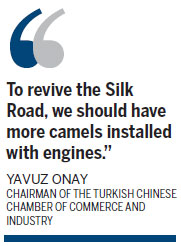In Northwest China's vast sun-scorched desert, a camel train plods along the ancient Silk Road.
The 7,000-km road linking East Asia and Europe was once jammed with caravans of Chinese silk, Indian spices and Persian brocade. Now the camels carry tourists from around the world.
"Those merchants must have been expecting a good price for their goods after all this hardship," said Beijing accountant Guo Ying, 25, after her bumpy camel ride.
Centuries after war and competition from sea routes led to its decay, the Silk Road is rising again, as both East and West are taking another look at the routes that maintained stability and prosperity from China to the Mediterranean.
At a construction site in Jiayuguan, Gansu province, trucks haul construction materials for a new train terminal. The high-speed link between Lanzhou, capital of Gansu province, and the Xinjiang Uygur autonomous region will soon be launched.
"Caravans are quaint, but we need more railways and air routes," said Lou Qinjian, 58, governor of Shaanxi province.
About 1,500 years ago, merchants from Central Asia, the Middle East and Western Europe braved the Gobi Desert and nomadic bandits to arrive at Xi'an, then known as Chang'an and at the time the world's largest metropolis.
The province now has found itself much nearer the center of Central Asia. Shaanxi now trains at least 1,000 students from Central Asian countries every year. Lou has organized direct flights between Almaty in Kazakhstan and Xi'an, Shaanxi's capital.
President Xi Jinping's proposed "Silk Road Economic Belt" revival project could involve more than 40 Asian and European countries and regions with a combined population of 3 billion.
For Chinese retailer Huang Jie in Kazakhstan, Xi's idea is great news. Over 20 years ago, Huang married a Kazakh man and started a store selling cooking utensils in Almaty, once a major logistic hub on the Silk Road. Almost all the goods in Huang's emporium are imported from China.
"They sell very well here," she said, pointing to a daily turnover that can hit 9 million tenge ($49,000).
Farther west, Istanbul was the starting point for numerous arduous trips along the road over past millennia.
Today, products from Yiwu, Zhejiang province, the world's largest wholesale market, are piled high in the Turkish city's Grand Bazaar.
Yavuz Onay, chairman of the Turkish Chinese Chamber of Commerce and Industry, is planning to make China a bigger business partner.

"I am endeavoring to be the Marco Polo of the 21st century," said Onay, who helps Turks do business in China and brings Chinese investors to his country.
"To revive the Silk Road, we should have more camels installed with engines," he said.
High-speed rail from Istanbul to Ankara and a Bosphorus rail tunnel between Asia and Europe are both part of Turkey's effort to make itself a key juncture on the new Silk Road.
"We have been in action to connect Turkey with Central Asia and Europe, even as far as Britain, with high-speed railways," said Omer Onhon, deputy undersecretary of Turkey's Ministry of Foreign Affairs.
Meanwhile, in South China, Guangzhou is the only port of the old Maritime Silk Road where maritime trade never ceased.
Last year, Xi proposed the "Maritime Silk Road of the 21st Century" along the less-well-known ocean route that linked the Pacific and Indian Oceans.
Ali Ismail Mahyiddin, a Yemeni expatriate who owns a restaurant in Guangzhou, has found his fate closely related to the Maritime Silk Road, which made Guangzhou - his current home - a cultural and religious metropolis.
"Everyone here is always ready to help me," he said.
Xinhua
